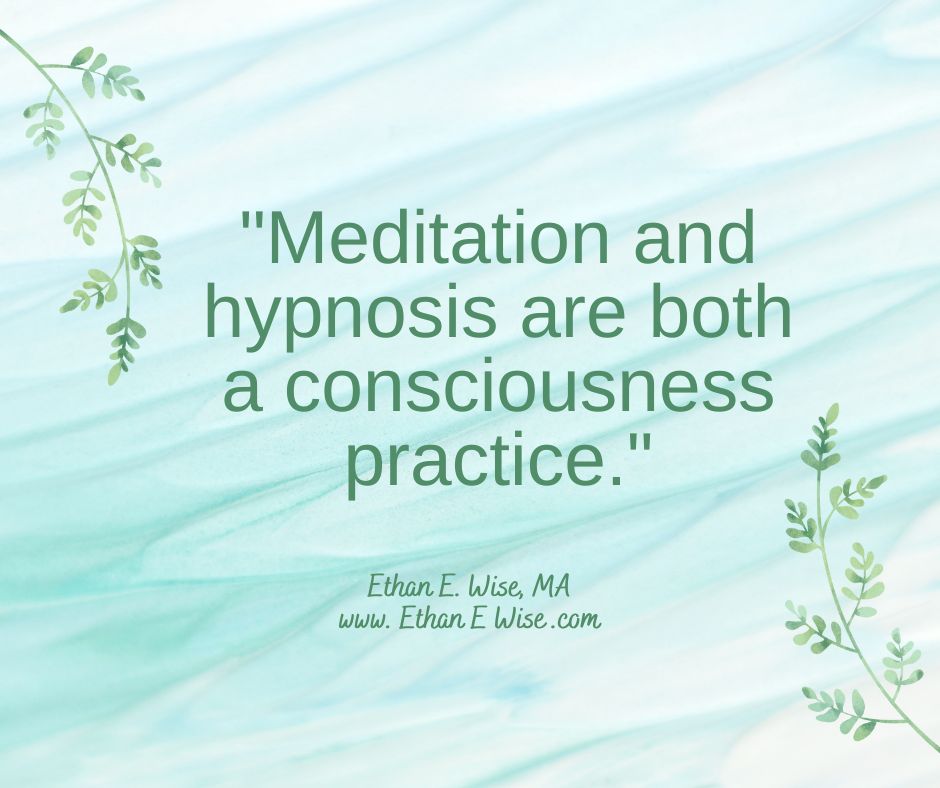Meditation and hypnosis are two practices, or phenomena, that have been around for thousands of years, but have become increasingly popular in recent times. While there are some differences between these two practices, they in reality share many important similarities, historical, neurological, and in their impact. In fact, in my practice, I inform my clients that hypnosis and meditation are practically the same phenomena, with a difference being our “intention” and what we do with the experience.
One of the most known similarities between meditation and hypnosis is that both involve a state of deep relaxation and focused attention.
In the most common forms of meditation, the individual is often encouraged to focus on the present moment or their breath, letting go of any distracting thoughts. This can lead to a deep state of relaxation and mental clarity.
In most hypnosis experiences, the individual is guided into a relaxed state, often through the use of breathing, focus, relaxation, and images, allowing them to let go of distractions and focus their attention on the hypnotic suggestions, feelings, age regression, etc.
Both offer a therapeutic effect on the mind and body. Research has shown that meditation can help to reduce stress, improve sleep, and boost overall mental health (1). Hypnosis has also been shown to have therapeutic benefits, particularly in the treatment of anxiety, depression, and other mental health conditions (2). Both produce similar outcomes of stress reduction, changing thought patterns, and increased self-awareness. (6,8,9)
Additionally, both meditation and hypnosis involve similar brain wave states and neural activity. In meditation, the brain moves from a state of beta waves, associated with alertness and stress, to alpha waves, associated with relaxation and focus (3). In hypnosis, the brain also moves into a state of deep relaxation and focus, with changes in brain wave patterns, particularly in the alpha and theta wave frequencies (4).
Another similarity is that both practices require an individual to have a certain degree of motivation, willingness, relaxation, and agreement. Both states involve the use of visualization, mindfulness, and trance-inducing techniques.
Generally and most frequently, both meditation and hypnosis are safe and non-invasive practices. There are no known serious side effects associated with either practice, although some people may experience feelings of disorientation or confusion following meditation or hypnosis (5).
When exploring the ancient and modern history and use of hypnosis and meditation, one finds a significant amount of overlap. In fact, in many cases they both appear to describe the same phenomena.
To summarize the above and generalize an answer, one could say that hypnosis and meditation involve similar altered states of awareness, so similar they may be considered to be the same phenomena, with the difference being in the intention and intended outcomes. Another difference is how each state of mind is achieved. Some use imagery while others use breathing. Hypnosis is thought to be a non-religious practice while meditation is often linked to spirituality. Both require focus and willingness.
Are hypnosis and meditation the same thing? The short answer is yes! But, of course don’t forget the nuances

.
Just as meditation is not religious or spiritual but could be used within a religious or spiritual context, hypnosis is the same! In this article, from WiseHypnosis.com, I complied useful thoughts and discussions relating to the use of hypnosis by Christians.
Learn more about hypnosis, the history of hypnosis, self-hypnosis, and inductions by visiting my website Wise Hypnosis .com
References / learn more:
1- Khoury, B., Sharma, M., Rush, S. E., & Fournier, C. (2015). Mindfulness-based stress reduction for healthy individuals: a meta-analysis. Journal of Psychosomatic Research, 78(6), 519-528.
2- Barber, J. (2004). Hypnosis, trauma, and psychotherapy. American Journal of Clinical Hypnosis, 46(4), 261-279.
3- Travis, F., & Shear, J. (2010). Focused attention, open monitoring and automatic self-transcending: Categories to organize meditations from Vedic, Buddhist and Chinese traditions. Consciousness and Cognition, 19(4), 1110-1118.
4- Spiegel, H. (1997). Hypnotic and therapeutic suggestions: A review and theoretical analysis. American Journal of Clinical Hypnosis, 40(1), 47-63.
5- Berkovich-Ohana, A., Glicksohn, J., & Jospe, M. (2015). Altered states of consciousness and their implications for self-awareness, creativity, and well-being. Frontiers in Psychology, 6, 1161.
6- “Meditation and Hypnosis: Two Different Methods with Similar Outcomes” by Christiane Northrup, M.D.
7- “Meditation vs. Hypnosis: What’s the Difference?” by Eric Grace
8- “Meditation and Hypnosis: A Match Made in Heaven” by Dr. Andrew Weil
9- “Meditation and Hypnosis: Understanding the Connection” by Dr. Deepak Chopra
10- “Meditation and Hypnosis: Similarities and Differences” by David R. McManus
11- Stay tuned .. this article is being edited and more will be added here 1/29/2023 Ethan E Wise